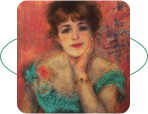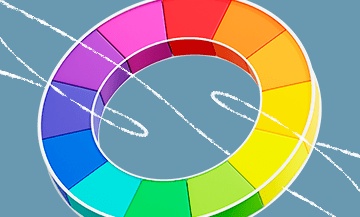What is a portrait in painting: the mystery of human nature
Portraiture in painting is a captivating and unique art form that allows us to peer directly into the soul of a person on canvas. It is a way to convey not only external beauty but also the inner world, emotions, and character of a personality.
Why is portraiture so important in the history of art? Because it preserves the images of people, their beauty, and their uniqueness forever.
By looking at a portrait, we can be inspired, reflect, and seek ourselves and others in these works. They offer us the chance to see the world through the eyes of the artist and delve into the inner world of the depicted characters.
Portrait in drawing, painting and art
Portraiture in art is a captivating bridge between the artist’s soul and their subject, a moment captured in time, a mastery that transfers emotions and stories onto canvas or paper. This magnificent art form takes on the task of showing us not only the face of a person but also their essence, their dreams, their pain, and their joys.
The art of portraiture lies at the heart of human experience. From the ancient pharaohs of Egypt to the great masters of the Renaissance and contemporary artists, portraits have always served as an important means of self-expression and understanding human nature.
Each portrait hides a unique story. It can be a mirror reflecting the artist’s feelings and mood, their perspective on the world, or it can be a moment when the artist tries to capture the eternal traits of the human soul. Portraits may conceal deep symbols, revealing to us the boundless world of human fate.

The art of portraiture experiences an eternal rise, with each artist bringing their own perspective and style to it. In a portrait hides the mystery of a story that can be unraveled by observing the eyes, smile, or expression of the person. We ponder who we are, where we come from, and where we are going…
A portrait can penetrate the deepest corners of the soul, revealing the most intimate thoughts through the language of color, form, and light.
The diversity of styles and techniques in portraiture allows us to immerse ourselves in the world of different eras and cultures, where each brushstroke or pencil mark creates a stunning harmony between reality and imagination, between the visible and the invisible.
History of the emergence and development of portraiture
The first attempts to depict the human form on canvas can be traced back to ancient civilizations. In Egypt, Greece, and Rome, sculptors and painters created busts and reliefs depicting rulers, gods, and important figures. These works of art were not merely images but symbols of power and wealth.
The Middle Ages brought the development of iconography, where saints and religious figures became the main subjects of depiction. However, it was during the Renaissance, starting from the 14th century, that portrait painting began its grand journey.
Renaissance masters, Leonardo da Vinci and Raphael, embodied new ideas in portrait painting. They aimed not only to convey a person’s appearance but also to express their character and emotional state. Through the use of more realistic techniques and light and shadow, artists were able to create portraits that truly came to life on the canvas.
Over time, portrait painting spread throughout Europe and the world, acquiring various styles and directions. Baroque added expression and drama, Romanticism delved into human emotions, and Realism sought maximum accuracy.
With the advent of photography and the art of the twentieth century, portrait painting faced challenges and transformations. Modernism and Abstract Art contributed to this field by presenting more abstract and symbolic images.


Today, portrait painting continues to live, evolve, and inspire artists. It immerses us in the world of emotions and stories of each individual, as well as allows us to see ourselves and others in a new light.
Variations of the portrait genre
In the world of art, there are countless variations of the portrait genre, each inspiring and surprising.
 Classicism: this variation of the portrait is characterized by strict composition and emphasized meticulousness in detail. It often explores the ideal of beauty and restraint in emotional expression. Classicism portraits frequently embody grandeur and inner strength.
Classicism: this variation of the portrait is characterized by strict composition and emphasized meticulousness in detail. It often explores the ideal of beauty and restraint in emotional expression. Classicism portraits frequently embody grandeur and inner strength.

Impressionism: Impressionists aimed to capture moments, emotions, and impressions, creating portraits that represent the atmosphere more than precise details. This style emphasizes light and color, making the painting appear “alive” and ever-changing.

Expressionism: in this variation, the artist seeks to convey deep emotions and the inner world of the subject. Expressionist portraits can be vivid and abstract, with creative and bold colors.

Surrealism: opens doors to a world of fantasy and the subconscious. Surrealist portraits are mysterious and even a bit eerie.
 Renaissance Portrait: Renaissance portraits are distinguished by skill and realism. With deep symbolic meanings, they emphasize the importance of the human figure and spiritual depth.
Renaissance Portrait: Renaissance portraits are distinguished by skill and realism. With deep symbolic meanings, they emphasize the importance of the human figure and spiritual depth.

Abstract Portrait: abstract portraits explore geometric forms, color combinations, and textures — abstract art is open to free interpretation.
Each artist’s touch in the portrait genre is unique, just as the person standing before the canvas is. Portraits allow us to forget about time and enjoy this moment of eternity, peering into the soul and discovering its inexhaustible secrets.
Types of portraits according to composition for each room

Classic Portrait: portraits in the classic style are suitable for a living room or library. They add elegance to the space and create an atmosphere of respect for art.

Family Portraits: family portraits, depicting various generations, are perfect for a living room or dining room.

Children’s Portraits: in a child’s room, you can display bright and joyful portraits of your little ones. This will create a warm atmosphere.

Nature Portraits: for the bedroom, nature portraits — such as seascapes or mountain peaks — are suitable. They help create a calm and relaxing environment in the room.

Abstract Art: if you want to give the room a modern look, display abstract portraits. These artworks can be interpreted in various ways, but they certainly make the interior unique.

Celebrity Portraits: in a home office or reading room, you can display portraits of famous personalities — let them inspire you.
Portrait painting from photography
Art is reborn with each brushstroke, coming to life on blank canvases and inspiring us with beauty. Such is the power of portrait painting, capable of transferring everyday facial features onto timeless pieces of art.
But what if I told you about portrait painting from photographs? Modern technology has transformed this elegant art form into something unique and captivating. Old black-and-white snapshots, lost in time, can be revived before us in vibrant colors, recreating our ancestors and their stories.
When a photograph becomes the basis for artistic creation, something more than mere resemblance emerges. The artist’s skill lies not only in capturing every detail of the face and expressing emotions but also in delving into the unseen stories behind each line and shadow.
If you decide to commission a portrait painting from a photograph, you open the door to a world of magic. Your image, transferred to canvas, will come to life.
And what could be more thrilling than watching an artist create a small masterpiece right before your eyes? In that moment, you see the artist’s hands transform a photograph into a work of art, giving it new life. So don’t hesitate and let your portrait live another life, this time on canvas.
Portraiture Tools, Materials and Techniques
Tools are indispensable assistants in the hands of an artist. The main ones are:
- Brushes of various sizes and shapes, allowing for a range of lines and strokes.
- Additionally, pencils and charcoal pencils for sketches and outlines.
- An eraser for corrections and organizing light and shadow, as well as an easel or palette for mixing paints.

Materials for portrait painting vary depending on the artist’s preferences. However, the most common ones are acrylic or oil paints.
One of the most popular techniques in this genre is layered painting. This technique involves applying different layers of paint and blending them to create smooth transitions. Another technique is the “tortoise” technique—creating numerous small and fine dots for texture and detail effects.
The use of the right tools, materials, and techniques by the artist results in beautiful and expressive portraits.
Famous masters and works in the portrait genre
Among the renowned masters of portraiture, one cannot overlook the Italian artist Leonardo da Vinci. His famous work in this genre—“Mona Lisa”—has become an icon of world painting. In the face of Lisa Gherardini, Leonardo encoded the mysteries of the smile and human emotions, creating an invaluable work of art.
Another outstanding master of portrait painting was the Spanish artist Diego Velázquez. Through his work, King Philip IV and his family came to life on the canvas, gaining an unparalleled poignancy and depth. Velázquez used the play of light and shadow to convey the features of each face and reveal its character.
The French artist Jean-Baptiste Greuze is rightly considered one of the founders of the portrait genre. His works are distinguished by a genuine sense of life and attention to minute details. Greuze succeeded in capturing not only the physical likeness but also the soul of his subjects.
Famous masters and their stunning works in the portrait genre are just the tip of the iceberg in the world of portrait painting. Each artist brings something new and unique, making this genre vibrant and unpredictable. Because a portrait is not just an image of a face; it is a reflection of the soul, emotions, and the stories hidden behind them.
This painting is unburdened by standards and constraints; it captivates the viewer with its frozen mystery. The character on the canvas is hidden behind translucent curtains, like a secret hero of a drama, inviting the viewer to peer into a world of intrigue and enigma.


Portrait in modern art
Contemporary artists, nurtured in the spirit of bold experimentation, are redefining the traditional understanding of portraiture. They are not confined to physical likeness but strive to express something more—an inner world, the essence of a personality, its inner life.
The colors on the canvas transition from deep blues, symbolizing melancholy and mystery, to vibrant, pulsating reds, conveying passion and energy. The contrasts and transitions of colors create something magical, where each brushstroke is a note in the symphony of life.
Technique also becomes an integral part of the portrait in contemporary art. From hyperrealism, where every detail is recreated with astonishing precision, to abstraction, where forms and lines create a unique dance of imagination. Experiments with materials, textures, and shapes give the portrait a distinctive and memorable individuality.
The themes of portraits in contemporary art also go beyond traditional concepts. Artists may depict not just the face but the entire world within and around the character. These can be profound thoughts, emotional experiences, relationships with the surrounding world—everything that makes a personality unique and complex.
Still, a modern portrait is not a static image but a dynamic and living picture, an invitation to a journey into the world of emotions.
I can help enhance the interior of your home—order portrait paintings from my gallery. I create various themes and artworks that inspire and make you a little happier.
- 90% of my paintings adorn interiors in homes and offices in Ukraine and 10% worldwide.
- 100+ of my clients came to me through recommendations from acquaintances and other clients.
Contact me personally to order a painting.
Phone: +38 098 770 10 22
I look forward to our fruitful and inspiring collaboration!
Question-answer
- Psychological Portrait — focuses on the inner states and feelings of the person.
- Celebrity Portraits— as the name suggests, these portraits depict famous people: politicians, actors, singers, etc.
- Family Portraits— images of family groups or individual family members. They show the connections and interactions between relatives.
- Children’s Portraits— these are images of children, which can be executed in various styles and techniques.
- Portraits with Animals— portraits of people that include their pets. Such paintings highlight the bond between humans and animals.
- Formal Portraits— these portraits usually depict people in formal attire or poses.
- Group Portraits— images of several people at once.
During the Renaissance, artists like Leonardo da Vinci and Raphael viewed the portrait as a means of expressing individuality. They aimed not only to capture the physical form of a person but also to convey their inner world and uniqueness.
In the Baroque period, portraits became a means of visualizing power and wealth. Artists like Rubens and Van Dyck created majestic portraits, emphasizing the luxury and status of their subjects.
With the arrival of Classicism and Romanticism, artists sought to express emotions and sensuality in their portraits.
Modernists like Picasso and Matisse experimented with form and color, breaking traditional norms of portraiture.
Today, the portrait school continues to evolve, reflecting a variety of cultural and social contexts. With the advent of new technologies and diverse artistic approaches, contemporary artists explore the portrait as a means of expressing various aspects of human personality.




